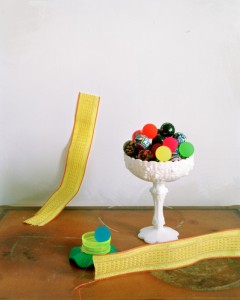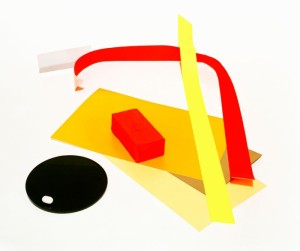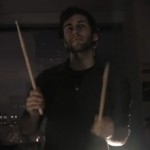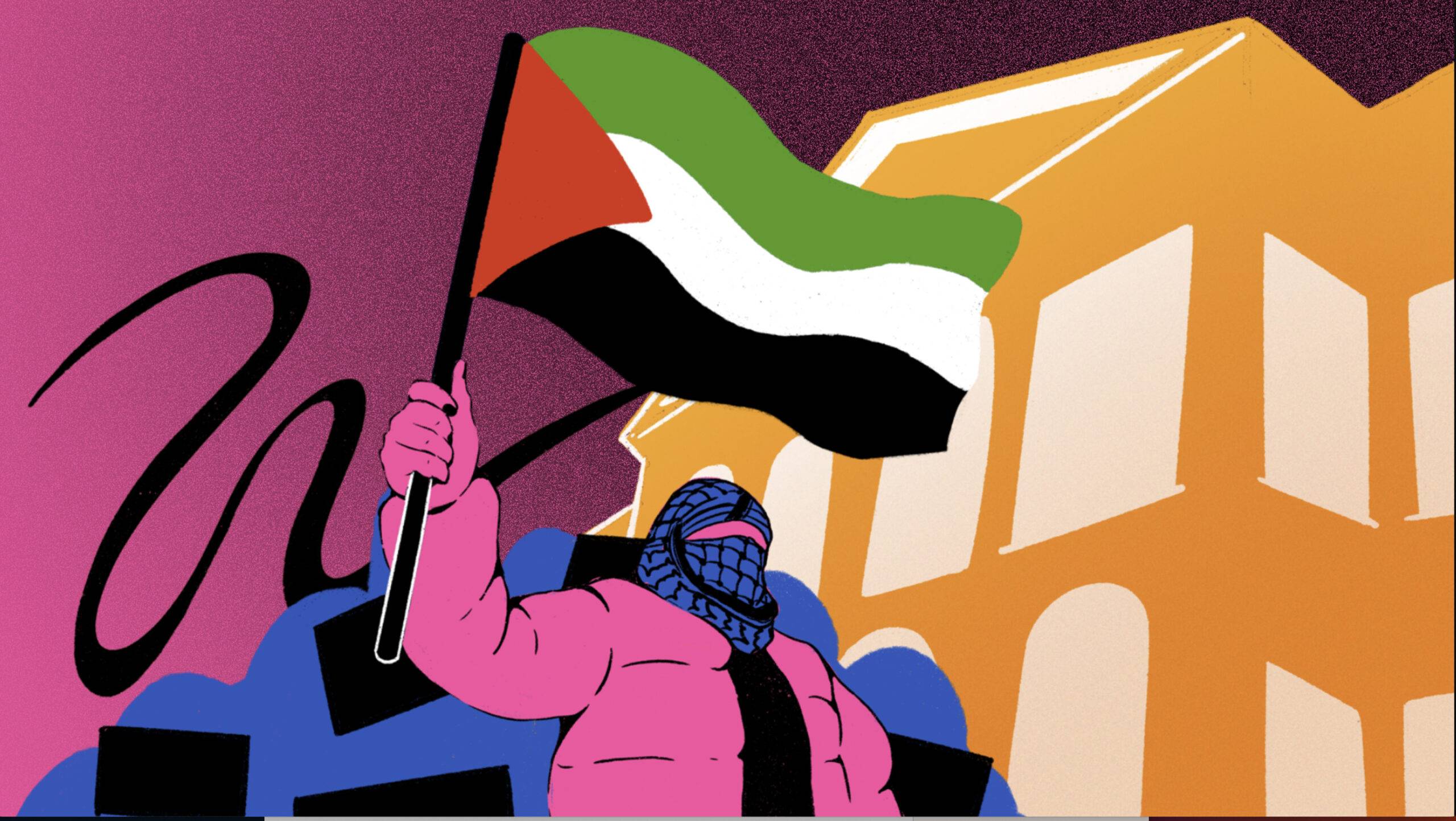By Ziyuan Wang, Staff Writer
Last December, SAIC alum Jessica Labatte was featured as the 100th artist to participate in the Museum of Contemporary Art’s UBS12 x 12 New Artists/New Work exhibition. This came on the heels of several other solo exhibitions around the city, making Labatte a quickly rising young photographer to watch. F Newsmagazine recently caught up with Labatte to learn more about her practice and artistic interests.
Coming from a multi-disciplinary background at SAIC, Labatte has always been enchanted by the infinite possibilities photography has to offer. The use of found objects became integral to her image-making as she found her way through various artistic practices, including performance, installation art, and photography.
Disparate aesthetics are at play in her work, from plays on Marcel Duchamp’s found objects to references to the rich history of abstraction. Her work calls to mind the physical process of “writing with light.” By isolating the essential formal components of the image, her work stresses the two-dimensionality of photographic imagery.
In these visually appealing photographs, the most quotidian objects are invested with a transformative power. Labatte avoids digital forms of image-making; instead, such complex visual illusions are achieved with the most mundane daily objects and a minimalist manipulation of light and focus. Slices of reality are rendered unrecognizable, highlighting photography’s unstable nature as something between the authentic and the deceptive. Her work provides viewers with a way of looking, rather than objects to look at. Labatte’s role as a photographer is to orchestrate an open-ended visual experience, which she said will “evolve on its own.”
Ziyuan Wang: How did you get initiated into photography? How has your experience of art school shaped your aesthetics?
Jessica Labatte: I went to boarding school in Canada for a year. Each year the [art] class you could take was in a different media, but it just so happened that the year I was there it was a photography class. I took it and fell in love with photography. After that I took photography classes every year, even when I moved to a different high school.
When I came to the Art Institute as an undergrad, I didn’t know much about contemporary art. From where I came from in Utah, I didn’t have many chances to be exposed to it. The Art Institute blew my mind open; I got into performance, sculpture and installation. All these new possibilities for making were a major influence on the work I was doing. The school encouraged us to take classes from various departments, so I learned many skills that still mingle together in my photography. From the beginning I was always setting scenes up for the camera. I was either collecting things, or building sculptures out of different materials, but all for the end result of the photograph.
ZW: Have you figured out what this medium means to you?
JL: I’m trying to be more specific about my use of photography, but I don’t think that I have it all figured out. Trying to figure out what photography means to me is what keeps me making pictures. When I came to grad school I was more interested in meaning and using materials symbolically, to create metaphors. During grad school, I began to think more about the physical processes of photography, and about formal elements that seemed to be overlooked in other conceptual photography.
This was a big transition for me, shifting from trying to work with very specific metaphors, to working with formal aesthetic decisions and open-ended meanings. My work became more about visual experiences for the viewer, and also more about processes and activities for me in studio. I let myself be intuitive rather than pre-planning everything or making a rigid conceptual statement. I intend to make things that evolve on their own.
ZW: So how are all the interdisciplinary explorations integrated into your photography?
JL: I have made sculpture and other things, but I would always come back to photography, which turns out to be the most fulfilling and successful — not only for myself, but for how other people respond to it as well. Every time I try to stray into other media, it ends up influencing photography. Obviously, there is a sculptural connection to my images, and for me there is a lot of performance that happens while I am building the images, but in the end the work is always about photography.
Photography is dependent on recording things pre-existing in the world. I like the fact that photography has this relationship to the real world. I think its ability to act as an objective recording device of ephemeral or metaphysical qualities, such as space, time, light, or other transient experiences, is what makes it really exciting. The indexicality of my images is where the real magic happens, since these things really existed this way in the studio, even though they may appear digitally altered, or collaged, or unreal.
ZW: What possibilities of photography interest you the most? Do you see any limitations in this medium?
JL: I like the process of taking pictures using the large format camera. There is something magical about the way the camera sees things differently than we see them with our eyes. Photographs are so good at representing reality, we view them as truthful recordings of reality, even though the images are often times deceiving in their representation. In my images there are always ties to things we know in the real world, which seduce you because you can relate to them. But something happens within the images that make them seem unusal or strange. This mistranslation, or misrepresentation, is one of the things I am most interested in. Something I’m also drawn to in photography is the freedom it gives me to make something and then deconstruct it, and I still have a record or proof of its existence.
In terms of limitations, I feel that there is not enough work dealing with formal problems of photography. Photography always seems to be about something, or it has meaning or metaphor attached to it. But how can you make it merely deal with forms, color, and things painting can be about? Or how can you make photographs about spatial problems, like you might experience in sculpture and installation art?
Its two-dimensionality and flatness seem to be the limitations that I’m trying to play with most right now. Because the camera is a supposedly objective recording device, it doesn’t allow for too much individual expression, which is partially why I am taking this route of doing performance-based installations, or works that look like abstract paintings. It brings a sort of emotion or expression back into the work, both in its creation and in the final images.
ZW: Looking at your complete oeuvre, I see two distinct styles. One is the chaotic accumulation of domestic items stacked up into humongous piles, the other looks like clean and flat still life compositions. How do you decide on and develop these two kinds of strategies?
JL: The larger chaotic piles came first. I will do one, larger installation, but at the same time, I will be working on smaller things. And I do that partially because working on the big projects requires so much attention and focus that sometimes I need to divert my energy to something else to give myself a little break. So, the little works become moments away from bigger pieces. What ends up happening is that I will be working on a large piece, making a lot of intuitive decisions about color and placement and such, while I am arranging things. And then when I looked at the images later, I notice things happening [that are] worth extracting or isolating in the smaller works. These are moments where two forms become very flat; or intersect with other objects at an angle where they become confusing; or something doesn’t have a shadow; or something would pick up a reflection of something else in a different way. A lot of those things I learned without intending to. When I discovered elements that I wanted to draw attention to, I would isolate and refine them.
ZW: Can you talk more about how do you compose your image and manipulate with the light?
JL: I’m not doing anything to manipulate the light. The overhead lighting in my studio is so evenly lit that most of the objects don’t have shadows. With the compositions, it starts with decisions about selection — should I buy this, or should I include that, should this go next to this or next to that, and so on. Then once I start to compose something, I’ll make some decisions first. For example, I want to use a black backdrop, because in my last piece the black color looked really nice, so I want to work with that again. From there I’ll just go with the objects that I found and collected along the way. So, if I found this amazing piece of drywall, maybe this will be the first piece I want to include. After that I’ll start to put everything together with the camera out in a specific position. I’ll go place something and walk across the room, then look into the camera, and then go over and place the next item. Once I decide that that object is right I’ll add the next thing, one after another.
This will go on for a while. Sometimes I decide that the addition of this new chair just made that cabbage I put in five steps ago obsolete, so I’ll have to remove that. It’s a long process, but that’s how the selection goes in the studio.
I use a 4 x 5 large format camera to shoot everything, which in and of itself is a very slow process. My photos are all 15-second exposures. This is because the overhead lighting in my studio is fluorescent tube lights, just like the fluorescent lights in the classrooms, so to shoot with an aperture somewhere between F42 and F45 is a 15-second exposure.
ZW: What do you consider to be the reality being represented in your work?
JL: To me, what happens in the picture is a documentation of our material culture. The pictures become confusing or deceiving, which may speak to my feeling that things in contemporary society aren’t totally stable. You don’t always have a clear understanding of how things are happening, and lots of things that seem real contain illusions.
ZW: You mentioned the feeling of being unstable, which is what I get from looking at your work. The objects in your photography seem to mutate into something else.
JL: I like that a lot. I was reading a lot about formlessness recently, an idea about things decaying into an in-between state. This is an exciting idea to me, not only about how forms could be formless, but how meaning could be formless too. That meaning wouldn’t have to be a fixed thing, it could be fluctuating. Photography is about freezing the moment, but the pictures can still be active so that they exist in an in-between state.
In this photography class I was teaching we discussed reality. Even the way cameras compress space or render forms is not accurate as to how we experience it. So why would that be more truthful than our individual and varied experiences? In my work you can see that photography is deceiving, but it’s still [perceived as] an objective recording. There are so many factors along the way that can interfere with the accurate recording, like exposure, depth of field, the processing of film, printing … there are so many decisions you have to make along the way, that it seems ridiculous to think that these images are totally objective.
ZW: It seems to me that the ambiguity in your work makes the meaning open-ended.
JL: There is an interesting quote about how people find ambiguity very scary and threatening, and how you feel anxious when things are ambiguous. But I find that fascinating, because there is no way we can have a complete understanding of even the simplest situations. The fact that we think everything is clear is an illusion; there are five million ways to interpret one thing.
My work is about photography’s precarious tie to authenticity, and how aesthetics and perceptions have the potential to effect us. I believe formal elements are important, and maybe they are actually more important than a rigid, conceptual structure. Maybe my work looks like it’s just my personal expression, but I want my images to be more about having an open experience between myself and the viewer, in a way that the viewers can have an experience not being predicted by me.
What I’m trying to do is to make works completely dependent on visual forms, and that ambiguity is tied up in the forms — so the experience of looking can be confusing.
ZW: Where do you see yourself going in the future? Will you be dedicated to formal issues in photography?
JL: I don’t have a definite answer for that. My work always evolves out of what came before, so it is hard to predict what will be next. My show at the MCA opened up new interests, such as working with the space around the camera. Also, the way we installed the work in the gallery drew attention to the fact that all the Surface Effects were generated by the large piece, The Brightness. The installation kind of mimicked the way the work was created in the studio. Another interesting direction within The Brightness is how the picture can activate the relationships between objects. The contrast of color can create vibration, so viewers can feel the strength or intensity of their relationships next to each other. That’s something I’m excited to play with.
For more of Labatte’s work, visit jessicalabatte.com
[Ed. Note: This article has been edited after it was originally posted]

























